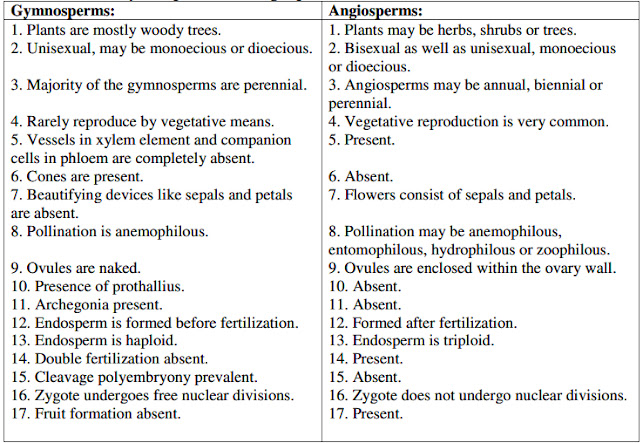Gymnosperms
Gymnosperms:-
> Gymnosperm:- “Gymnos” = necked and “Sperma” = seeds.
> The word Gymnosperm was first used by Theophrastus, a pupil of Aristotle in his famous book
“Enquiry into Plants”. He used this term in all those plants having unprotected (without covering) seeds.
General account:-
1. Occurrence:- Gymnosperms are found all around the planet. Most of them are present in the temperate and subarctic regions of the northern hemisphere.
2. Size:- Gymnosperms include only tall, perennial trees. The smallest gymnosperm is Zamia pygmaea, and the tallest is Sequoia sempervirens. Gnetum ula is a woody climber.
3. Plant body:- The plant body is sporophyte and divided into root, stem, and leaves.
4. Habit:- Gymnosperms are mainly evergreen and woody plants. Most of the gymnosperms are trees and shrubs. A few of them may be liana or climbers.
5. Life Span:- As gymnosperms do not produce fruits or flowers, it takes a longer time in fertilization and development. For example, a pine tree can have a lifespan of over \(100\) years.
6. Roots:- They have a fibrous root or taproot system.
7. Stems:- They are woody plants, so they have erect stems. Stems of gymnosperms can be either unbranched or highly branched.
8. Leaves:- Leaves may be simple, needle-like (Pinus, Juniper, etc.) or compound like palms. (Cycas), with a thick cuticle.
There are two main types of leaves:
a. Foliage leaves:- These are green and photosynthetic.
b. Scale leaves:- These are on the nodes and short branches, brown in colour and non-photosynthetic.
9. Xylem:- The xylem carries water and minerals to different parts of the plant and provides support. Vessels are absent in the xylem of gymnosperms. Gnetum has vessels in the secondary wood.
10. Phloem:- In most of the cases, the sieve tube, companion cells are absent in the phloem. Instead, they have sieve cells to conduct food. Albuminous cells are present in pine in place of companion cells.
11. Flower:- They do not produce flowers.
12. Microsporophyll:- In gymnosperms, microsporophyll is hard leafy triangular clusters of male cones that bear microsporangia that contain microspores.
13. Megasporophyll:- In gymnosperms, megasporophyll bears a female gamete, megasporangia containing only one megaspore. Male and female cones may be borne on the same plant (Pinus, monoecious) or different plants (Cycas, dioecious).
14. Pollination:- Pollen grains are carried from male cone to female cone by wind (Anemophily).
15. Gametophyte:-
a. Male gametophytes:- They are formed from haploid microspores. Male gametophytes or pollen grains are extremely reduced to a limited number of cells.
b. Female gametophytes:- They are highly reduced and are formed from haploid megaspore. There are integuments, so the ovules are called integumented megasporangium. All gymnosperms (except Gnetum) are unitegmic.
16. Endosperm:- They have haploid endosperms.
17. Seeds:- The seeds are naked in gymnosperms and borne in cones that are not visible till maturity.
Affinities and Relationship of Gymnosperms:- Gymnosperms occupy a place in between pteridophytes and angiosperms in the plant kingdom. Therefore, gymnosperms bear close affinities with the pteridophytes on the one hand and the angiosperms on the other. In many other characters they differ from both.
Resemblances or Similarities with Pteridophytes:-
i. Sporophytic, independent plant body is present in both the groups. It is differentiated into root, stem
and leaves.
ii. Sporophyte possess a well-developed vascular tissue.
iii. Xylem lacks vessels and phloem companion cells.
iv. Young leaves show circinate vernation.
v. Presence of megaphyllous leaves.
vi. Gymnosperm and few pteridophytes e.g. Selaginella are heterosporous i.e. form micro- and
megaspores in micro- and megosperangia, borne on the micro and megasporophylls respectively.
vii. In Cycas, sporangia are grouped in sori like pteridophytes.
viii. The female sex organ is archegonium in both the groups.
ix. The male gametes of Cycas and Ginkgo are motile like the pteridophytes.
x. Permanent retention of megaspore within the megasporangium.
xi. Gametophytes are endosporic and highly reduced.
xii. Female prothallus develops before fertilization and there is free nuclear division.
xiii. Germination of spores is precocious in gymnosperms and hetrosporous pteridophytes.
xiv. Development of distinct embryo after fertilization.
xv. Like the pteridophytes, gymnosperms show marked alternation of generation between
gametophytic and sporophytic phase. Sporophytic generation or sporphytic phase is dominant,
independent and large at maturity while the gemetophtic generation exhibits progressive reduction and
dependence.
Difference between Gymnosperms and Pteridophytes:-
Similarities with Angiosperms:-
i. Main plant body is sporophytic and is differentiated into root, stem and leaves.
ii. Plants are trees or shrubs and may be erect or climbing.
iii. Root system is well developed and the roots may be diarch, triarch, tetrach or polyarch.
iv. The xylem is exarch in the roots.
v. Stem is eusteltic. Vascular bundles are conjoint, collateral, open and endarch.
vi. Secondary growth takes place.
vii. Wood may be monoxylic or polyxylic.
viii. Vessels and companion cells also occur in some gymnosperms (Gnetales) like angiosperms.
ix. Heterosporous and have reduced gametophytes.
x. Nucellus is surrounded by integument to form a structure called ovule.
xi. Like gymnosperms many angiosperms are wind pollinated.
xii. Megaspore permanently remains inside the megasporangium and develops into female
gametophyte.
xiii. Pollen grains grow into pollen tube.
xiv. Male gametes are non-motile in majority of gymnosperms and angiosperms.
xv. Fertilization is siphonogamous.
xvi. Suspensor is formed during development of embryo.
xvii. Formation of endosperm.
zviii. Formation of seeds from ovules.
xix. As in gymnosperms, polyembryony is found in several angiosperms.
xx. Embryogeny is endoscopic.
xxi. Life cycle is similar in both groups.
Difference between Gymnosperms and Angiosperms:-

